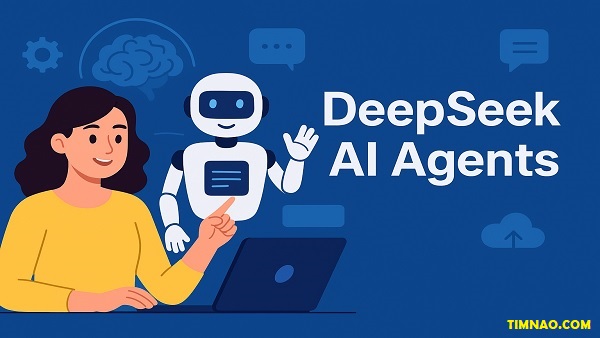🚀 Unlock Smarter Workflows: How DeepSeek AI Agents Supercharge Productivity (Even for Beginners) 🤖
DeepSeek AI Agents are changing the way we think about automation. They’re not just chatbots that answer questions—they’re powerful digital teammates that can reason, remember, and act. Imagine an assistant that not only chats with you but also organizes your inbox, summarizes long reports, manages your social media, and learns from every interaction. That’s the promise of DeepSeek.
What sets DeepSeek apart from other AI tools is its combination of long-term memory, hybrid reasoning, and seamless integrations. This means your agent can hold detailed conversations without losing context, connect to real-world apps like GitHub or Discord, and improve its performance over time. For beginners, it’s like having a personal productivity partner that grows smarter the more you use it.
This guide is designed to help you unlock that potential. We’ll walk through everything—from starting with no-code platforms to building Python-powered agents, deploying them in the cloud, giving them personality, and even teaching them to self-improve. Along the way, you’ll learn practical steps, see real-world examples, and discover how to keep your agents safe as they take on bigger roles.
If you’ve ever wondered how to bring AI into your daily workflow without needing a PhD in computer science, you’re in the right place. Let’s explore how DeepSeek AI Agents can transform your productivity starting today.
📝 Table of Contents:
- 🤔 AI Agents Explained: Why DeepSeek Is More Than Just Another Chatbot
- 🛠️ No-Code Start: Build a Simple Agent With DeepSeek Blocks
- 💻 From Prototype to Code: Why DeepSeek-V3.1 Makes Python Agents Smarter
- 📂 Teaching Your Agent to Handle Real Data (GitHub, Docs, and APIs)
- 🧠 Hybrid Reasoning in DeepSeek-V3.1: Giving Agents True Memory and Smarts
- ⚡ From Talk to Action: How DeepSeek Agents Execute Real Workflows
- ☁️ Deploying DeepSeek Agents in the Cloud Without Hassle
- 📡 Running Fully Autonomous DeepSeek Agents Safely
- 🎭 Crafting Personality-Driven Agents With DeepSeek’s Long Context
- 🌍 Expanding Reach: DeepSeek Agents on Discord, Email, and Social Media
- 🔄 Self-Improving Systems: How DeepSeek Supports Continuous Learning
- ⚠️ Risks & Safety: What Every Beginner Should Know Before Scaling
- 🛤️ Roadmap: Starting Your DeepSeek Agent Journey Today
🤔 AI Agents Explained: Why DeepSeek Is More Than Just Another Chatbot
When most people hear the term AI agent, they imagine a chatbot like ChatGPT or a virtual assistant such as Siri. While those tools are impressive, they are limited to conversations. You type a question, they reply with text, and that’s usually where the interaction ends.
But AI agents—especially when powered by DeepSeek—are designed to go much further. They don’t just talk; they act. Think of them as digital teammates that can reason, take instructions, and carry out tasks automatically. Instead of simply suggesting ideas, they can fetch real data, analyze files, run workflows, and even improve their performance over time.
DeepSeek stands out because it isn’t only optimized for chat. The latest version, DeepSeek-V3.1, was built with something called hybrid reasoning. That means it can switch between two modes: a fast, lightweight mode for simple responses, and a deeper, more reflective mode for complex problem-solving. This balance allows it to be both quick and smart—something most chatbots struggle to achieve.
Another key difference lies in tool integration. Traditional chatbots are isolated; they answer based on what they were trained on. DeepSeek, however, is designed for the “agent era.” It can call APIs, analyze documents, interact with platforms like GitHub, and even coordinate across multiple apps. That’s why people describe it not as “just another chatbot” but as an automation engine with intelligence built in.
For beginners, this distinction matters. If you’re exploring AI for the first time, it’s easy to get stuck in the mindset that “AI equals chat.” But with DeepSeek agents, you’ll discover that AI can manage your tasks, handle data, and serve as a behind-the-scenes assistant—like having an extra pair of hands in your digital workspace. And because DeepSeek is open-source and beginner-friendly, you don’t need a massive budget to get started.
🛠️ No-Code Start: Build a Simple Agent With DeepSeek Blocks
Now that you understand how DeepSeek agents differ from chatbots, let’s roll up our sleeves. The good news? You don’t need to write a single line of code to try it out. There are beginner-friendly platforms that let you build your first DeepSeek agent visually, using drag-and-drop blocks.
These no-code tools work like LEGO. Instead of programming in Python, you connect “blocks” that represent actions: one block for receiving input, another for processing it with DeepSeek, another for fetching data, and another for outputting results. By linking these pieces together, you’re effectively designing a mini workflow.
For example, suppose you want to create a simple “email summarizer.” Using a no-code tool:
- Add a block that pulls your unread emails.
- Add a DeepSeek block to analyze and summarize the content.
- Add an output block to send the summary to your phone or Slack.
In less than 20 minutes, you have an agent that saves you from wading through a full inbox. No coding required, and yet you’re already experiencing how AI can transform daily tasks.
Popular No-Code Platforms to Try with DeepSeek
- n8n: An open-source automation tool where you can connect DeepSeek to hundreds of apps.
- Zapier: A user-friendly service for linking apps and creating simple automations. DeepSeek can be added as the “brain” that processes text.
- FlowiseAI: Tailored for building AI agents specifically, with DeepSeek support coming through API integration.
These platforms let you experiment without being overwhelmed by programming. Later, if you decide to switch to Python, you’ll already understand the logic of workflows—making the transition smoother.
Beginner Example: A Task Reminder Agent
Imagine you often forget small tasks, like “send follow-up email” or “review a file.” With a no-code DeepSeek agent, you can build a workflow like this:
- Input block: capture tasks you type or send via Telegram.
- DeepSeek block: interpret the task and set a deadline.
- Calendar block: create reminders in Google Calendar.
By the end, you’ll have your own AI-powered personal assistant reminding you of deadlines—without downloading yet another productivity app.
Why No-Code First?
Starting with no-code is like using training wheels. You focus on learning how agents think and how workflows connect, instead of wrestling with syntax errors or debugging. Once you’re comfortable, you can gradually add coding skills to build more advanced agents.
Another benefit: you get results fast. Instead of spending weeks reading tutorials, you can build something useful in a single afternoon. That quick win keeps motivation high, which is crucial when you’re just starting out.
By now, it’s clear that DeepSeek is more than a chatbot—it’s a practical way to start building digital assistants that actually get work done. Even the simplest no-code agents can summarize emails, organize tasks, or answer questions from your project documents. When you see how quickly these small automations make a difference, AI starts to feel less like a novelty and more like a reliable coworker.
The best part is that this foundation doesn’t go to waste. Everything you learn from connecting no-code blocks prepares you for the next step: making your agents smarter with Python and DeepSeek-V3.1. That’s where you’ll discover how to work with real data and unlock more advanced workflows.
💻 From Prototype to Code: Why DeepSeek-V3.1 Makes Python Agents Smarter
Once you’ve experimented with no-code platforms and seen what a basic DeepSeek agent can do, you may feel ready for the next level: coding. Writing your own Python scripts unlocks far more control. You can customize behaviors, connect to unique data sources, and even chain together multiple agents into a system that feels like a digital team.
This is where DeepSeek-V3.1 really shines. Unlike many language models that focus only on generating text, DeepSeek was designed for the agent era. Its hybrid reasoning system means it can switch between “quick thinking” and “deep thinking” modes. In practice, this gives you faster responses when you need them, but also more thoughtful, step-by-step analysis when a task is complex.
Let’s say you’re building a Python agent that checks the latest issues on a GitHub repository. With most chatbots, you’d get a summary of the issues in plain text. But with DeepSeek-V3.1, you can prompt it to analyze the issues, prioritize them, and even suggest which ones to fix first. That’s a huge upgrade from a passive chatbot—it’s like having an intelligent project assistant.
Another reason Python pairs well with DeepSeek is the ecosystem. Python has libraries for just about everything—requests for APIs, pandas for data analysis, LangChain or LlamaIndex for chaining AI logic, and Flask for web apps. When you integrate DeepSeek into this environment, you’re not limited to “ask and answer.” You can build agents that fetch, analyze, and act—automatically.
Here’s a simplified example of calling DeepSeek from Python:
import requests
API_KEY = "your_deepseek_api_key"
url = "https://api.deepseek.com/v1/chat/completions"
payload = {
"model": "deepseek-v3.1",
"messages": [
{"role": "system", "content": "You are a helpful AI agent."},
{"role": "user", "content": "Summarize the open issues on this GitHub repo: https://github.com/deepseek-ai/DeepSeek-V3.1"}
]
}
headers = {
"Authorization": f"Bearer {API_KEY}",
"Content-Type": "application/json"
}
response = requests.post(url, json=payload, headers=headers)
print(response.json()["choices"][0]["message"]["content"])
Even if you’re a beginner, this example shows how simple it is: you send instructions, DeepSeek responds with structured output, and you can do anything you want with it afterward. Over time, you’ll refine your prompts, structure responses, and build agents that behave consistently.
📂 Teaching Your Agent to Handle Real Data (GitHub, Docs, and APIs)
One of the most exciting things about building DeepSeek agents in Python is that they can work with real data sources. Instead of living in a vacuum, your agent can read files, connect to GitHub repositories, or pull information from APIs. This is the step where your project stops being a demo and starts becoming a useful tool.
1. Connecting to GitHub
Imagine you’re managing an open-source project. Instead of checking issues manually, you can build a DeepSeek agent that automatically:
- Reads the list of open issues from GitHub’s API.
- Asks DeepSeek to summarize them by category (bugs, enhancements, questions).
- Flags urgent issues based on keywords like “critical” or “broken.”
- Suggests the order in which to tackle them.
With Python, you’d use the GitHub REST API to fetch issues, then pass them into DeepSeek for analysis. Suddenly, what used to take 20 minutes of reading is now a two-minute automated workflow.
2. Working with Documents
DeepSeek agents can also handle text-heavy files. Suppose your team stores project documentation in PDFs or Word docs. Using Python libraries like PyPDF2 or docx, you can extract text and feed it into DeepSeek. The agent could then:
- Generate summaries of each section.
- Create FAQs automatically from long documents.
- Answer team members’ questions about the content without anyone needing to skim through pages.
This is powerful for students, researchers, or small business owners who juggle lots of paperwork. Instead of feeling overwhelmed, you let an AI agent do the heavy lifting.
3. Integrating External APIs
Real-world workflows often span multiple services. Maybe you want an agent that pulls sales data from Shopify, analyzes it, and sends a performance report every Monday. With Python, you can easily connect these dots:
- Shopify API → Fetch sales data.
- DeepSeek → Analyze trends, spot anomalies, and draft a report.
- Slack API → Deliver the report to your team.
By mixing data pipelines with DeepSeek’s reasoning, you’re turning raw numbers into insights—and doing it automatically.
Why DeepSeek Works Well with Real Data
The secret sauce is DeepSeek’s long context window (up to 128k tokens). That means it can actually read and process large files or extended datasets without losing track. Many models choke on long inputs, but DeepSeek handles them gracefully. This is why it’s ideal for tasks like reviewing technical docs, analyzing codebases, or interpreting logs.
At this point, you’ve seen how moving from no-code to Python opens up an entirely new world. With DeepSeek-V3.1, your agents don’t just respond—they think, prioritize, and adapt to real data from GitHub, documents, and APIs. This is where beginners start to feel the “magic” of agents: the leap from novelty to productivity.
And yet, there’s still one missing ingredient: memory. In the next section, we’ll explore how to give your DeepSeek agents long-term smarts so they don’t just respond in the moment but also learn and improve over time.
🧠 Hybrid Reasoning in DeepSeek-V3.1: Giving Agents True Memory and Smarts
One of the biggest frustrations with most chatbots is their short-term memory. You ask a question, get an answer, then come back later and the model has completely forgotten what you discussed. It feels more like talking to a parrot than working with a real assistant. DeepSeek-V3.1 changes that by introducing hybrid reasoning and extended memory.
Hybrid reasoning means the model doesn’t always think in the same way. When the task is straightforward—like rewriting a sentence or pulling a quick definition—it uses a fast reasoning mode to give you results instantly. But when the task is complex—like analyzing a codebase or comparing financial trends—it switches to deep reasoning mode, breaking the problem into steps. This flexibility makes agents both efficient and reliable, a combination that’s rare in AI.
Memory takes this even further. Instead of treating each conversation as brand-new, a DeepSeek agent can store and retrieve past information. Imagine you’re working on a long-term project: your agent can remember goals, track completed tasks, and remind you of unfinished ones without needing to be re-taught every day. This feels less like a chatbot and more like a real teammate.
Real-Life Example: Personal Knowledge Base
Suppose you’re a student keeping notes across multiple classes. A standard chatbot could summarize your notes if you pasted them in, but it wouldn’t remember what you showed it last week. A DeepSeek agent with memory, however, could:
- Store your lecture notes in a database.
- Recall past lessons when you ask a new question.
- Connect the dots between different topics over time.
Instead of you stitching knowledge together, the agent does it for you. That’s a huge leap in usability.
How Beginners Can Add Memory
You don’t need advanced coding to give your DeepSeek agent memory. Even a simple setup works:
- Use a database (like SQLite or Firebase) to store user inputs and outputs.
- On each new query, fetch the most relevant past interactions.
- Pass those past interactions into DeepSeek along with the new question.
Tools like LangChain or LlamaIndex simplify this by handling retrieval automatically. As a beginner, you don’t have to build the memory system from scratch—you just plug DeepSeek into the framework and let it handle context.
Memory and hybrid reasoning together make agents feel more “human.” They don’t just answer; they learn, adapt, and build continuity. This is the foundation for moving from simple assistants to true digital coworkers.
⚡ From Talk to Action: How DeepSeek Agents Execute Real Workflows
Up until now, we’ve focused on conversation, summarization, and reasoning. But here’s the real magic: DeepSeek agents don’t stop at talk—they take action. Instead of handing you advice and expecting you to do the work, they can actually execute workflows on your behalf.
Think of workflows as sequences of steps that would normally take your manual effort. Checking emails, analyzing a spreadsheet, creating a calendar event—these can all be automated by an agent that understands instructions and interacts with tools.
Example 1: Automating Customer Support
Say you run a small online shop. Instead of answering the same customer questions repeatedly, you build a DeepSeek agent that:
- Reads new customer inquiries from Gmail or a support ticket system.
- Uses DeepSeek to draft personalized replies.
- Sends the responses automatically—or routes complicated ones to you.
Now, your customers get instant replies, and you only step in when the issue is beyond automation. This saves hours every week while keeping service quality high.
Example 2: Weekly Reports Without the Effort
Many professionals spend Mondays compiling reports from spreadsheets or dashboards. A DeepSeek agent can:
- Pull sales or project data via an API.
- Analyze patterns with DeepSeek’s reasoning.
- Format the insights into a polished report.
- Email the document or send it to Slack automatically.
What used to be a half-day task now happens in the background, reliably, week after week.
Example 3: Personal Task Manager
Even individuals can benefit. Imagine you send your agent a quick note: “Remind me to review the marketing plan Friday morning.” Instead of just logging the request, the agent:
- Creates a Google Calendar reminder.
- Adds the task to your productivity app.
- Pings you on Slack at the right time.
That’s no longer a chatbot—it’s a proactive assistant executing real-world actions.
Tools to Make This Easy
For beginners, the simplest way to turn DeepSeek talk into action is by combining it with automation platforms:
- Zapier or Make: Connect DeepSeek to hundreds of apps with no coding.
- n8n: A free, open-source tool where you can build complex automations visually.
- Python scripts with APIs: If you’re comfortable coding, you can directly trigger actions like creating files, sending messages, or updating databases.
Why DeepSeek Works So Well for Workflows
DeepSeek’s ability to reason step-by-step makes it particularly effective for workflows. For example, if you ask it to process invoices, it doesn’t just dump text—it can classify expenses, calculate totals, and flag unusual entries. This reasoning ability means the actions it takes are more intelligent than simple “if this, then that” automations.
By now, you can see that DeepSeek agents don’t just talk—they think, remember, and act. The combination of hybrid reasoning, memory, and workflow execution means you can trust them with meaningful parts of your daily work. And we’re only scratching the surface.
The next big step is making these agents available anywhere—on the cloud, across devices, and integrated into the tools you already use—so they’re always ready when you need them.
☁️ Deploying DeepSeek Agents in the Cloud Without Hassle
Building an agent on your laptop is exciting, but the real value shows when it’s available anytime, anywhere. If you can only run your DeepSeek agent when your computer is on, you’re limiting its potential. Cloud deployment fixes this by making your agent accessible 24/7—ready to process tasks, monitor data, or interact with users at any time.
The good news? Deploying in the cloud isn’t as intimidating as it sounds. Beginners often imagine they’ll need expensive servers or advanced DevOps skills, but modern cloud platforms have simplified the process. You can start small, pay only for what you use, and scale up as your agent gets more responsibility.
Step 1: Pick Your Cloud Platform
Some of the most beginner-friendly platforms include:
- Replit: Run Python scripts in the cloud with almost no setup. Perfect for testing prototypes.
- Render or Railway: Great middle ground for deploying apps with a few clicks.
- Google Cloud Run or AWS Lambda: Ideal for lightweight agents that should “wake up” only when needed, saving cost.
- Heroku: A classic beginner-friendly option for deploying Python apps quickly.
The choice depends on how much control you want. If you’re just starting, services like Replit or Render make the learning curve very gentle.
Step 2: Prepare Your Agent for Deployment
At its core, deploying is about packaging your agent so it can run on a server. Most agents can be wrapped in a simple Flask or FastAPI app. Here’s a very basic example:
from flask import Flask, request, jsonify
import requests
app = Flask(__name__)
@app.route("/ask", methods=["POST"])
def ask():
user_input = request.json.get("question")
response = requests.post(
"https://api.deepseek.com/v1/chat/completions",
headers={"Authorization": f"Bearer {YOUR_KEY}"},
json={"model": "deepseek-v3.1", "messages": [{"role": "user", "content": user_input}]}
)
return jsonify(response.json())
if __name__ == "__main__":
app.run(host="0.0.0.0", port=8080)
This simple app lets anyone send a POST request with a question, and the agent replies. Once wrapped like this, your app can be deployed to almost any cloud service.
Step 3: Keep It Running
Cloud platforms handle uptime for you, but you’ll also want to:
- Add logging to track when your agent is used.
- Set environment variables for sensitive data like API keys.
- Use free tiers wisely—most platforms give plenty of room for small projects without charge.
With these steps, your DeepSeek agent transforms from a personal project into a cloud-based assistant available to teammates, clients, or even the public.
📡 Running Fully Autonomous DeepSeek Agents Safely
Once your agent is deployed in the cloud, the next frontier is autonomy—letting it run on its own without constant human input. But this is where things get tricky. An autonomous agent can take actions at scale, and if you don’t set boundaries, it can cause unintended problems.
What Autonomy Really Means
Autonomy doesn’t mean the agent is sentient or making decisions on its own. It means you’re giving it a degree of freedom to:
- Continuously monitor data sources.
- Trigger actions when conditions are met.
- Adjust its behavior without you needing to press “run.”
For example, a DeepSeek agent could:
- Check your company’s website logs for downtime.
- Alert you immediately on Slack when something breaks.
- Spin up a backup server if downtime is detected.
All without you watching over it.
The Safety Net: Guardrails
When beginners hear “autonomous,” they sometimes imagine losing control. The reality is you can design guardrails that limit what your agent can do. A few common safety measures include:
- Rate limits: Restrict how many actions an agent can take in a day.
- Approval steps: Require human confirmation for major actions (e.g., sending invoices, deleting files).
- Sandboxing: Run the agent in a controlled environment where mistakes can’t harm your main systems.
By combining autonomy with guardrails, you get the best of both worlds: powerful automation without the risk of chaos.
Beginner-Friendly Tools for Autonomy
If you don’t want to write all the logic yourself, platforms like LangChain Agents or AutoGen by Microsoft give you templates for running autonomous agents safely. These frameworks let you:
- Define tools your agent is allowed to use (like APIs or databases).
- Control how decisions are made step by step.
- Monitor outputs so you can step in if needed.
DeepSeek plugs neatly into these frameworks because of its reasoning abilities. Instead of blindly running workflows, it evaluates steps and explains its thinking, which gives you transparency and trust.
Real Example: Automated Research Assistant
Imagine you’re a startup founder who wants to track industry trends. You could set up an autonomous DeepSeek agent to:
- Scrape news sites daily.
- Summarize important articles.
- Send a digest email every morning.
With guardrails in place, it won’t accidentally spam you or access irrelevant sites. You gain insights passively, with almost no effort.
Why Safety Matters
It’s tempting to jump straight into “hands-off” automation, but safety ensures your agent helps instead of hinders. Think of it like teaching a new employee: you give them more freedom gradually, not on day one. Start by automating simple, low-risk tasks, then expand as you trust the system.
Cloud deployment and autonomy together turn DeepSeek agents into true digital coworkers. They’re not just answering questions when you remember to run them—they’re actively monitoring, acting, and supporting your work around the clock.
The next step is to make these agents not only reliable but also engaging by giving them a personality that connects with users on a human level. That’s where DeepSeek’s flexibility in tone and style becomes a real superpower.
🎭 Crafting Personality-Driven Agents With DeepSeek’s Long Context
Most people think of AI agents as robotic, flat, and a bit boring. That’s because most chatbots sound the same: polite but generic. What makes DeepSeek different is its long-context ability—it can hold onto much more information over extended conversations. This means you can give your agent a consistent personality, tone, and even backstory, making interactions feel more natural and engaging.
Why Personality Matters
When an agent has personality, users don’t just “use” it—they enjoy interacting with it. Imagine customer support that doesn’t sound stiff but instead has a friendly, reassuring tone. Or a study assistant that’s encouraging, cracking small jokes to keep you motivated. Personality makes the difference between a tool people tolerate and one they actually want to return to.
Defining Personality in Practice
With DeepSeek’s long context, you can define personality traits directly in the agent’s system prompt or memory. For example:
- Tone: “Always respond in a supportive and friendly tone, like a mentor.”
- Style: “Use simple language with short examples, avoiding jargon.”
- Persona: “You are a productivity coach who loves sports metaphors.”
Because DeepSeek can maintain context over thousands of tokens, these traits don’t get lost halfway through a conversation. That consistency is what keeps the personality believable.
Example: Customer Service Assistant
Let’s say you’re building an agent for a travel agency. Instead of sounding bland, you could design the assistant to feel like an enthusiastic tour guide:
- Greets users with warmth: “Welcome back! Ready for your next adventure?”
- Offers travel tips along with answers.
- Uses emojis sparingly to make the tone lively without overwhelming.
The result? Customers walk away smiling, even if they just had a simple booking question.
Example: Personal Productivity Partner
If you’re building an agent for personal use, imagine giving it the personality of a “no-nonsense accountability coach.” It could:
- Remind you of tasks in a direct, motivating way.
- Encourage you when you’re falling behind: “You’ve got this—just 20 more minutes and you’ll be done!”
- Adapt its tone based on your progress.
This makes your interaction less about commands and more about a two-way relationship.
How Beginners Can Start
You don’t need to be a writer to give your agent personality. A simple checklist works:
- Choose three adjectives for the tone (e.g., friendly, helpful, motivational).
- Decide on a role or archetype (mentor, coach, guide, colleague).
- Write a short background or style guide to feed into DeepSeek.
From there, test interactions and adjust until the personality feels right.
🌍 Expanding Reach: DeepSeek Agents on Discord, Email, and Social Media
Once your agent has a personality, the next step is giving it reach. Instead of running in isolation, why not let it interact where people already spend time—Discord, email, and social platforms? This is where your agent stops being a side project and becomes a visible, useful presence.
Deploying on Discord
Discord has become a hub for communities, from gamers to startups. Adding a DeepSeek agent here is powerful because it can:
- Answer FAQs in real time.
- Moderate discussions with clear rules.
- Offer summaries of long chat threads.
Beginners can use libraries like discord.py to connect DeepSeek to a Discord bot. The bot listens to user messages, sends them to the DeepSeek API, and posts the response back to the server. With personality traits defined earlier, the bot feels like a real member of the community rather than a faceless moderator.
Integrating With Email
Email remains a core business tool, and agents can save hours of manual effort:
- Drafting replies automatically.
- Sorting emails into categories like “urgent,” “later,” or “spam.”
- Sending weekly digests of important messages.
Using services like Zapier or n8n, you can connect your inbox to DeepSeek without writing much code. For example, Zapier can trigger a DeepSeek analysis every time a new email arrives, then forward the summary to you in Slack. It’s automation that feels invisible but makes a huge difference.
Going Social: Twitter, LinkedIn, and Beyond
Social media can be overwhelming, but agents can help here too:
- Content drafting: Have your DeepSeek agent suggest tweet ideas, captions, or LinkedIn posts in your chosen style.
- Engagement: Automatically reply to comments with polite, on-brand responses.
- Monitoring: Track mentions of your brand and send alerts when it’s time to step in.
With APIs for platforms like X (Twitter) and LinkedIn, your agent can integrate directly. For beginners, tools like Make simplify posting and monitoring workflows so you don’t need to manage raw APIs.
Example: Community Manager Agent
Imagine running a small startup Discord and a company LinkedIn page. Instead of manually juggling both, you could:
- Let your DeepSeek Discord bot answer common product questions.
- Have the same agent draft weekly LinkedIn updates with a consistent tone.
- Review its drafts before posting, keeping you in control.
Now, your agent isn’t just an assistant—it’s part of your brand’s communication strategy.
DeepSeek agents become far more powerful when they combine personality and reach. They stop being “tools in the background” and start acting like front-line team members, interacting with people across platforms while keeping a consistent style.
The next step takes this even further: building agents that learn and improve on their own, evolving into self-learning systems that become more valuable the longer you use them.
🔄 Self-Improving Systems: How DeepSeek Supports Continuous Learning
One of the biggest frustrations with older AI tools is that they remain static. You train them or set them up once, and from that point on they never get smarter unless you intervene. DeepSeek is designed differently—it enables agents to improve over time through feedback, iteration, and long-term memory. This makes it possible to create self-improving systems that evolve as you use them.
Why Continuous Learning Matters
Think of your AI agent like a new employee. On the first day, they might know the basics, but their real value shows as they learn from repeated tasks, mistakes, and feedback. Without that process, they remain stuck at an entry-level skill set.
For agents, continuous learning means they:
- Recognize mistakes and avoid repeating them.
- Adapt to new goals or changing environments.
- Build knowledge over time, making responses sharper and more relevant.
Instead of being a static chatbot, your DeepSeek agent becomes a partner that grows with you.
Simple Feedback Loops
You don’t need advanced AI training pipelines to make your agent self-improving. A feedback loop is enough:
- The agent makes a decision or produces an output.
- You rate or correct the result.
- The agent stores that feedback alongside the original task.
- Over time, the system recalls similar past cases and adjusts its behavior.
For example, if your agent drafts email replies and you often tweak the tone to be more formal, the agent can learn to default to formal replies next time.
Using DeepSeek’s Long Context for Learning
DeepSeek’s ability to handle long context windows is crucial here. Unlike models with short memory, it can analyze a history of interactions at once. That means you can feed in dozens of past tasks along with corrections, and the model can spot patterns: “Whenever the user marks an answer as ‘too casual,’ they want a more professional tone.”
This is a lightweight way of teaching without retraining the model. You’re essentially shaping its behavior with your own data.
Example: Automated Research Assistant That Improves
Suppose you’ve built a DeepSeek agent to summarize industry reports. In the beginning, it gives you overly detailed summaries. You mark them as “too long” and occasionally provide shorter examples. After several iterations, the agent begins to prioritize key highlights, giving you summaries that fit your preferred style.
The beauty is that this learning doesn’t require code-heavy retraining. It’s about storing examples, feeding them back into the agent, and letting DeepSeek’s reasoning engine spot the patterns.
Tools to Help With Self-Learning
Beginners can use frameworks like:
- LlamaIndex for storing examples and retrieval.
- LangChain Memory to manage ongoing context.
- Custom feedback forms in apps like Notion or Google Sheets to log corrections.
These tools provide simple ways to capture and reuse feedback without building complex machine-learning pipelines.
Continuous learning turns your agent from a one-off tool into a dynamic system that gets better the longer you use it. But as with any evolving system, there’s a flip side: risks you need to manage before scaling.
⚠️ Risks & Safety: What Every Beginner Should Know Before Scaling
It’s tempting to get carried away once your agent starts working. The idea of a fully autonomous, ever-learning assistant is exciting—but scaling too fast without safety in mind can create problems. Understanding risks early helps you avoid surprises.
Risk 1: Hallucinations
Even the best AI models occasionally “hallucinate”—producing confident but false answers. If you rely on an agent for research or customer support, this can mislead users or spread incorrect information.
Beginner Tip: Always start with low-stakes tasks. Let your agent summarize content, draft messages, or organize data—tasks you can easily verify. For high-stakes outputs, keep a human in the loop.
Risk 2: Over-Autonomy
Autonomous agents are powerful, but if they run without oversight, they can take unwanted actions—like sending too many emails, spending API credits, or overwriting files.
Beginner Tip: Add guardrails:
- Approval steps before major actions.
- Limits on how often tasks can run.
- Logging everything the agent does.
Risk 3: Data Privacy
If your agent handles sensitive data—like emails, financials, or customer records—you need to be mindful about where that data goes. Sending it to external APIs without protection could expose it.
Beginner Tip:
- Use environment variables to secure API keys.
- Avoid sharing sensitive personal data with third-party tools.
- For sensitive projects, consider self-hosted solutions.
Risk 4: Dependency on One Model
Relying 100% on one model or provider creates risk. If DeepSeek updates or changes pricing, your entire system could be disrupted.
Beginner Tip: Design your workflows with model flexibility in mind. Many frameworks let you switch providers with minimal effort. This way, you’re not locked into one option.
Risk 5: Scaling Costs
Running agents in the cloud or connecting multiple APIs can rack up costs if you’re not careful. It’s easy to start with free credits and then face unexpected bills as usage grows.
Beginner Tip:
- Monitor usage with built-in dashboards.
- Start small with free tiers.
- Set budget alerts where possible.
Building a Safety-First Mindset
The key is not to avoid scaling—it’s to scale responsibly. Start with experiments in a safe sandbox. Give your agent small jobs, watch how it performs, then expand gradually. Treat it like onboarding a new team member: you wouldn’t give them access to your company bank account on day one.
Example: Safe Scaling Path
- Start: Let the agent summarize Slack conversations.
- Next: Allow it to draft email replies (with approval).
- Later: Automate low-risk workflows, like filing reports.
- Eventually: Grant it more autonomy once you trust its performance.
This phased approach ensures your agent grows in capability without putting you or your organization at risk.
When you combine continuous learning with safety, DeepSeek agents transform from basic assistants into trusted digital coworkers. They get sharper over time, adapt to your style, and take on bigger responsibilities without causing chaos.
From here, the journey is about action. You’ve seen how agents think, learn, act, and even evolve. Now it’s time to plan your own roadmap—choosing the first simple project that brings all these ideas to life.
🛤️ Roadmap: Starting Your DeepSeek Agent Journey Today
If you’ve made it this far, you might feel both excited and a little overwhelmed. That’s completely normal. Building your first DeepSeek agent doesn’t have to happen all at once—you can break the journey into small, achievable steps. Think of this roadmap as a starter kit to guide your path.
Step 1: Clarify Your Goal
Don’t jump straight into coding or cloud deployment. Ask yourself: “What problem do I want my agent to solve?”
- Is it to manage your inbox?
- Help moderate a Discord community?
- Automate research tasks?
Start with a clear, specific outcome. A focused goal makes your project easier to design and test.
Step 2: Experiment With No-Code Tools
Before you dive into Python, play around with no-code environments. Platforms like Replit or Zapier let you connect DeepSeek to workflows without writing much code. This helps you quickly see results and gain confidence.
Step 3: Move Into Prototyping With Python
Once you’ve tested a simple agent, step into Python. Use lightweight frameworks like Flask or FastAPI to give your agent a basic structure. From there, integrate the DeepSeek-V3.1 API to handle reasoning and responses. Don’t worry about perfection—treat this as a sandbox.
Step 4: Teach It With Real Data
Next, make your agent useful by connecting it to sources you care about—GitHub repositories, PDFs, or company docs. Using libraries like LangChain or LlamaIndex, you can create a retrieval system where your agent fetches relevant information on demand.
Step 5: Give It Memory and Personality
With long-context support, DeepSeek agents can “remember” conversations and act with a consistent style. This is where you shape tone, personality, and user experience. Whether you want your agent to sound like a mentor, a coach, or a friendly colleague, this step makes it engaging.
Step 6: Deploy It to the Cloud
Once you’re happy with the prototype, move it to the cloud so it runs 24/7. Services like Render, Railway, or Google Cloud Run make this possible without heavy DevOps work. Now your agent is always available when you—or your users—need it.
Step 7: Scale Safely
Finally, expand carefully. Add autonomy, let it interact on Discord or email, and improve it with feedback loops. Always keep safety nets like guardrails and approval steps in place. Growth is exciting, but responsible growth ensures your agent remains trustworthy.
🙋 FAQs: Beginner Questions About DeepSeek AI Agents Answered
1. Do I need to know coding to start with DeepSeek agents?
No. You can begin with no-code tools like Zapier, Make, or Replit to test basic workflows. Coding becomes useful once you want more customization, but it’s not required to get started.
2. How is DeepSeek different from ChatGPT or other chatbots?
Most chatbots are designed mainly for conversations. DeepSeek, especially V3.1, is built with reasoning and tool-use in mind. That means it’s better suited for creating agents that take action, learn from context, and handle workflows—not just chat.
3. Is DeepSeek free to use?
DeepSeek has free trial options, but for long-term projects, you’ll need an API plan. The good news is that costs scale with usage, so you can start small and only pay more as your agent grows.
4. Can I run a DeepSeek agent on my phone or laptop?
Yes, for small projects. You can run agents locally, but for reliability and 24/7 availability, cloud deployment is recommended. Platforms like Heroku or Google Cloud Run make this simple for beginners.
5. How do I make sure my agent doesn’t “go rogue”?
Always build with guardrails. Add approval steps before critical actions (like sending payments or deleting files). Start with low-risk tasks until you’re confident in its behavior.
6. How can I teach my agent to improve over time?
Use feedback loops. When your agent makes a mistake, correct it and save the correction. Feed this data back during future prompts. Tools like LangChain’s memory modules can help your agent remember preferences.
7. What are some easy first projects for beginners?
- A meeting notes summarizer.
- An inbox triage assistant.
- A Discord FAQ bot.
- A personal study partner that quizzes you.
These projects are simple enough to build quickly but useful enough to show the power of DeepSeek.
8. Can I connect DeepSeek to social media accounts?
Yes. With APIs or automation platforms, you can connect DeepSeek to Twitter, LinkedIn, or Discord. Beginners often start with monitoring or drafting posts before moving to full automation.
9. What’s the biggest mistake beginners make?
Trying to do too much too soon. Start with one clear use case, build it well, and expand later. Small wins keep motivation high and prevent frustration.
10. How do I know when my agent is ready to scale?
If your agent consistently delivers accurate results in low-risk tasks, it’s ready to expand into more complex or autonomous roles. Think of it like training a new hire—give responsibility gradually.
Getting started with DeepSeek agents doesn’t require years of AI experience. By starting small, using simple tools, and focusing on one problem at a time, you’ll quickly see results. The beauty of DeepSeek is that it grows with you—from no-code experiments to autonomous, self-learning systems that act like true digital teammates.
The only real step left is the first one: choosing a small project and giving it a try. Once you see how even a simple agent can save time and effort, you’ll understand why so many people are turning to AI agents as part of their daily workflows.










I’m often to blogging and i really appreciate your content. The article has actually peaks my interest. I’m going to bookmark your web site and maintain checking for brand spanking new information.